-
Car Reviews
- All reviews
- Midsize SUVs
- Small cars
- Utes
- Small SUVs
- Large SUVs
- Large cars
- Sports SUVs
- Sports cars
- Vans
Latest reviews
- Car News
-
Car Comparisons
Latest comparisons
- Chasing Deals
Unbelievably, it’s been 21 years since the first Toyota Prius was released. Until Tesla’s arrival, the Prius was arguably the household name in hyper-economical driving – and over 7 million have been sold since the car’s debut in 1997, largely thanks to the frictionless ease of a petrol-electric hybrid motor where you simply drive as normal, and enjoy big fuel economy dividends in town. Because every Prius sold in Australia has been a traditional hybrid, the fact you fill them up at a regular petrol station meant it was super-easy to bring a Prius into the home without having to charge it up or learn new methods.
In fact, the huge success of the Prius spurned Toyota to create a full range of hybrid products, and partially-electrified Toyotas are a common sight on Aussie roads. Toyota’s Hybrid Synergy Drive brand is entrenched in the market, giving them a good lead in brand capital – but that doesn’t mean there is no room for a new player to come in and displace Toyota hybrids at the top of the economy-focussed sales charts.

Enter Hyundai – a brand on the rise and rise locally. The Korean maker’s Australian operation has seen a gap in the market for a more affordable hybrid to battle it out with the Prius on its own turf – and we’ve driven it. The 2019 Hyundai Ioniq will go on sale in November 2018, and unlike the Prius, it’ll be offered in three guises. There will be the ‘easy’ option – the petrol-electric conventional hybrid seen here, but the Ioniq will also be sold in plug-in hybrid (with 63km of electric range) and fully electric (200km range) forms. An assault on the fuel-efficient marketplace? You could definitely call it that.
Before the Ioniq invasion hits Australian shores, we decided a comparison was in order with the car that started it all. Focussing wholly on the stop-start, in-town driving these cars will be used for, we pit the 2019 Hyundai Ioniq hybrid against its chief foe, the 2018 Toyota Prius.
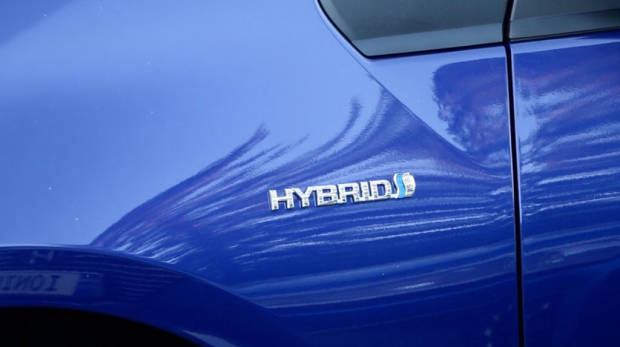
On test here is the Toyota Prius in base model form, priced at $36,440 (approximately $40,580 driveaway in NSW), and the Hyundai Ioniq Premium hybrid, which Hyundai have indicated will be priced around $35,000 (approximately $39,000 driveaway).
Right from the get-go, it’s interesting to note that Hyundai’s more luxurious Ioniq variant of two offered – the Premium – will likely be priced more affordably than Toyota’s base model Prius. Hyundai will also offer an entry-grade Ioniq, probably priced in the low $30,000 range. Meanwhile, Toyota sell a more expensive Prius grade, called the iTech, for $43,900 ($48,278 driveaway in NSW).
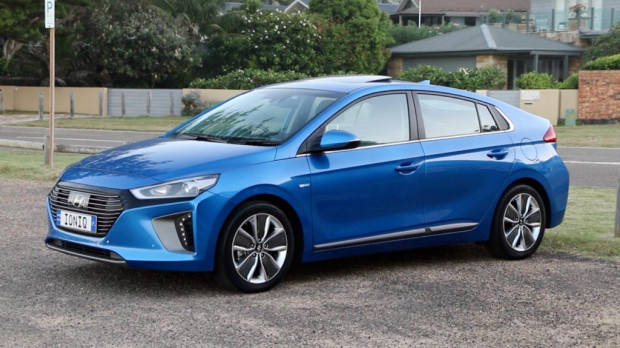
Before you can go out and test drive an Ioniq for yourself, there will be a brief wait until the car is officially launched in Australia. Hyundai have imported 70 trial examples of the Ioniq – one of which you see here in Electric Blue), but customer deliveries will only commence around the time of the Ioniq’s national launch, scheduled for the last week of November.
The Prius is available right now – effectively in three shapes. There is the five-door hatch seen here, but the Prius also comes in ‘Prius c’ (a Yaris-sized small hatch) and ‘Prius v’ (a seven-seat MPV) varieties.
There is substantial commonality in specification for the two cars competing in this test, though the Ioniq Premium does edge out the Prius when it comes to more luxurious comfort features.
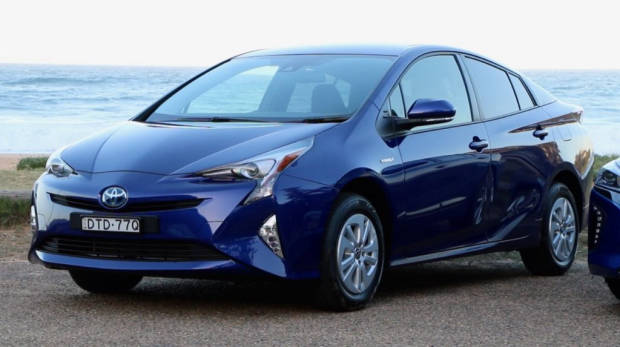
Between the pair, the Prius and Ioniq Premium both come fitted with autonomous emergency braking, radar cruise control, and lane departure warning. Both have LED daytime running lights, automatic headlights and keyless entry and start with auto-folding mirrors; inside, both have wireless smartphone charging, touchscreens with navigation, live traffic and premium stereos (JBL in the Toyota, Infinity in the Hyundai); climate control with a setting to divert air only to the driver.
Unsurprisingly, given its ‘Premium’ tagline, the Hyundai is more richly equipped, besting the Prius with leather seats, which are heated and cooled up front with electric adjustment and memory for the driver, and there’s a heated steering wheel with paddle shifters. The Hyundai’s touchscreen has Apple CarPlay and Android Auto integration, and the Ioniq’s 17-inch alloys look infinitely better than the Toyota’s 15s. The Hyundai gets more safety tech, too, in the form of blind spot monitoring and rear cross-traffic alert.
The Prius uniquely offers a head-up display, as well as automatic high beam lights and a rear windscreen wiper. Some of the Ioniq Premium’s more lush features – leather, heated front seats, blind spot monitoring, rear cross-traffic alert, LED headlights and 17-inch wheels – are added if you spend $7,460 more on the Prius i-Tech grade.
Out of the blocks, the Hyundai appears to deliver substantially better value for money – but is that enough to eclipse the Prius’s engineering depth and hybrid heritage? Read on.
Value for money winner: Ioniq
People who still think that hybrids can’t be fun to drive need to get behind the wheel of one of these cars – especially the Prius. Neither car here is laugh-out-loud fast, nor are they handling heroes, but they are surprisingly fun to send around corners and their serve of electric torque means they do build up speed in urban spaces quickly. The old adage that slow cars driven fast are the best is quite applicable to both these vehicles.
That said, most people specifically looking at a low-consumption ride are not after fun dynamics – though its nice that they are included on both the Prius and Ioniq even if they don’t really have to be. Driven gently in urban settings, both hybrids here are remarkably refined and easy to drive.
That said, the economy-focussed tyres fitted to both cars causes any abrupt low-speed handling manoeuvre generate moderate tyre squeal, but be gentle with the inputs and the Prius really surprises with its eager handling: Toyota’s stellar TNGA platform – that also underpins the impressive new C-HR, Camry and Corolla models – shines through.
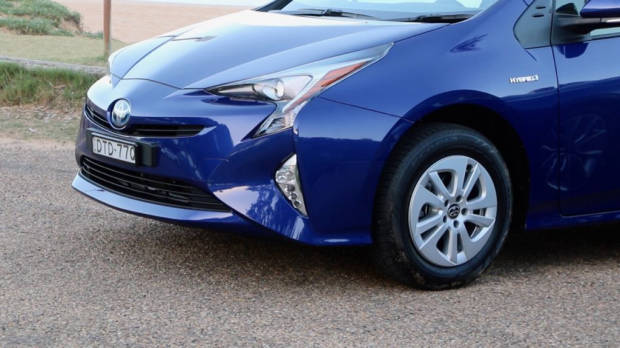
The Ioniq is a pretty accomplished handler, too, but you can definitely feel its 67kg of additional mass that it carries over the Prius. The Toyota feels a bit more nimble on its feet.
In their home setting – stop-start city traffic – there are certainly some noticeable differences in the way that these cars drive. The Prius is by some margin the more sorted and comfortable car around town, where bigger bumps aren’t felt as clearly as in the Ioniq. The Toyota’s suspension tune is soft yet its body control is disciplined and contrasts nicely with the Ioniq, which can feel crashy across large undulations and surface changes, which catch out the Hyundai’s additional weight.
Both hybrids here offer little in the way of steering feel, though the Ioniq’s heavier tiller does give its steering more natural weighting. But steering either car around town is a doddle – both have small turning circles and quick racks. Up the speed, and both are entirely happy on motorways, though the efficiency dividend of a hybrid diminishes rapidly at speed. In town, the batteries assist the generally small petrol engines, but at higher speeds, this is not possible and long hills at highway speeds make for a noisy experience.
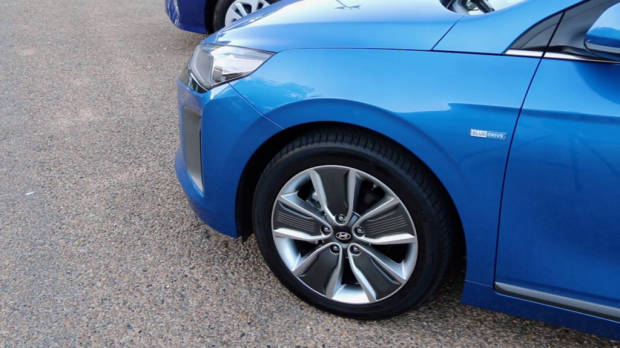
The drivetrains in these hybrids are surprisingly different, with Hyundai making a clear attempt to redress the Prius’s weaknesses. Both cars are powered by four-cylinder petrol engines with electric motors, which are charged simply by kinetic energy gained from braking or generated from the petrol engine.
In Australia, Toyota offers the Prius only with old and inefficient nickel hydride batteries, though more modern and efficient lithium ion units are available on overseas Prius models, which makes the car even more economical thanks to a higher storage limit and quicker charging time. Toyota Australia does not provide combined power and torque outputs for the Prius; the 1.8-litre engine is rated at 73kW/142Nm and NiMh electric setup at 53kW/163Nm. Sometimes the two work in concert; sometimes they do not.
Vastly superior lithium ion batteries are the sole units available on the Ioniq, and combined with its 1.6-litre p[etrol engine, the Hyundai produces 104kW of power and 265Nm of torque. Uniquely, the Ioniq is only available with a six-speed dual-clutch automatic transmission with manual shifting modes, in contrast to the Prius’s CVT automatic with a B mode for increased engine braking to increase the amount of juice put into the car’s batteries.
The Ioniq is equipped with a Sport mode, which makes the instrument cluster look cooler and slightly weights up the steering. Toyota give the Prius a Power setting, which draws more power more quickly from the batteries. The Prius uniquely has an EV mode – though with Ni-Mh batteries it doesn’t last long. It’d be nice to see this feature integrated on the Hyundai, where the benefit of its better Li-Ion batteries could be exploited for longer.
Ultimately, the Ioniq feels the fastest hybrid here thanks to its geared transmission. The Hyundai’s dual-clutch also allows the Ioniq to be more fuel efficient, thanks to increased reliance on low-end torque. A controlled back-to-back through heavy Sydney traffic netted a small but clear advantage for the Hyundai in the fuel consumption stakes: a superb 3.2L/100km result, while the Toyota delivered a (still excellent) 3.5L/100km – not much on a short drive, but 10 per cent difference in the life of the car will add up to a decent cost saving at the bowser.
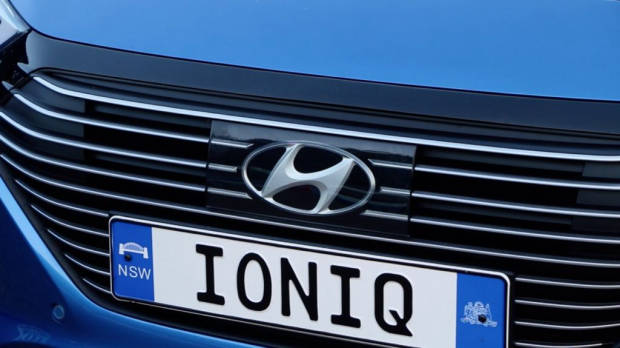
Outside of controlled settings, neither car’s fuel economy increased much for our testers over the week. The worst the Prius delivered at any point was 4.7L/100km, while the Hyundai’s poorest result was 4.5L/100km. Clearly, it’s easy to achieve really good economy in both these cars – you don’t have to drive really slowly!
Driving winner: Ioniq
We can’t think of two rivals cars that take a more differentiated approach to interior design. And we can’t help but believe this is intentional on Hyundai’s part: where the Prius goes wacky-futuristic, the Ioniq deliberately goes conventional and easy to understand.
The Toyota’s dashboard is almost space-age to look at, with the speedometer placed in the centre of the dashboard, underneath the windscreen. The centre console tunnel looks like a sculpture. The Prius shares barely any design elements with any other Toyota, which gives it a really unique feel – and it contrasts strongly with the Ioniq, which basically looks and feels like a slightly more upmarket Hyundai i30.
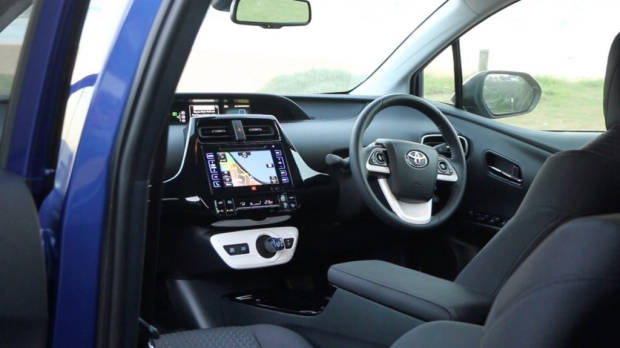
Despite the Prius’s radical look, the cabin is entirely liveable. The focal point is a seven-inch touchscreen that unfortunately, runs fairly dated software – but you will at least find navigation with live traffic and DAB+ digital radio here, paired with a punchy eight-speaker JBL stereo. The seats are covered in attractive but hard-wearing cloth – it’s just a shame they’re manually adjustable, even on a car that costs forty grand on road. Toyota’s own Camry hybrid Ascent, a base model itself, has electric seat adjustment for the driver but is almost $10,000 cheaper.
The Toyota’s driving position is sound with a good view out and an ergonomic dash layout. Material quality is quite good, with mostly soft surfaces around the front of the cabin, and an attractive metallic gloss black centre console trim that can admittedly attracts fingerprints. Most positive is that the Prius’ cabin isn’t at all dated, nor is it covered in Toyota parts bin parts either. It’s as unique as the exterior is, though thankfully not as polarising.
On the other side of the ledger, the Hyundai’s cabin is much more conventional to look at. It’s far less unique than the Toyota and makes much more liberal use of shared parts with similarly-sized Hyundai product like the i30 hatch and Tucson SUV. Considering its positioning and pricing, that is not necessarily a bad thing – but those looking for individuality or flair will look in the direction of the Toyota.
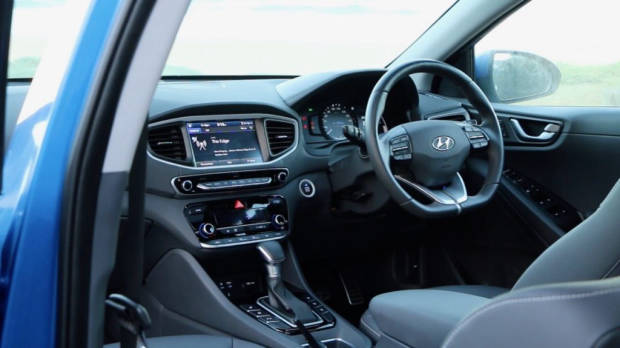
That said, the Ioniq is ultimately the more welcoming cabin, as it has far more standard kit that we would want if we lived with the car every day. The in-cabin technology is far superior in the Hyundai: it has a bigger eight-inch touchscreen that, like the Toyota, has navigation, live traffic and DAB+ digital radio, but goes further, with Apple CarPlay and Android Auto integration. Plus, Hyundai’s software is much easier to use and doesn’t lock you out while on the move.
The Hyundai’s driving position isn’t as low or sporty as the Prius, but the seats are better, with electric adjustment for the driver plus memory functionality. The heating and (especially in Australia) the cooling are nice to have – as is the easy-to-clean leather upholstery. But material quality isn’t as plush in the Ioniq as in the Prius. Much like an i30, a relatively thin veneer of soft material has been placed over hard points. The window and mirror switches don’t feel as nice and clicky, either – it would be nice to see higher-quality materials used in future.
Comfort winner: Draw. Toyota for design, Hyundai for functionality.
The two cars on test are fairly similarly-sized, though the Toyota Prius is the larger car. Measuring 4.54 metres in length, the Toyota is 7 centimetres longer than the Hyundai Ioniq, and the Prius is 4 centimetres taller, too, measuring 1.49m high. One reason the Ioniq feels a little more settled at higher speeds, though, is the fact the Hyundai is a considerable amount wider – 6cm wider, at 1,820mm.
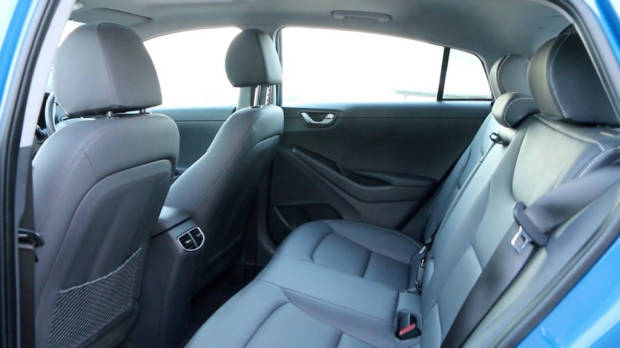
The back seat of the Ioniq hybrid.
To the eye, however, these cars look similar in size and they are. The boots are so similar that just one litre of cargo capacity separates them: the Hyundai has 456L, the Toyota 457L. Neither car has a very well-thought-out boot space, though, with the Toyota’s shopping bag hooks being traded for a net in the Hyundai Ioniq. That said, the Prius uniquely offers a space for its cargo cover to be stored under the boot floor when not in use.
The additional 7 centimetres of length makes the Prius the roomier car in the back seat, where both headroom and legroom are considerably up on the Ioniq. The Hyundai’s second-row bench does offer more amenities, though, with rear air vents in the door pockets (Toyota – back seat passengers do like to breathe, you know). The Ioniq also exclusively continues its soft-touch materials through to the back. Both cars have a centre armrest with two cupholders, map pockets, and door-mounted bottle holders. The Toyota uniquely has a 12-volt socket back here – but neither of them have the far more obvious USB ports in the back seat!
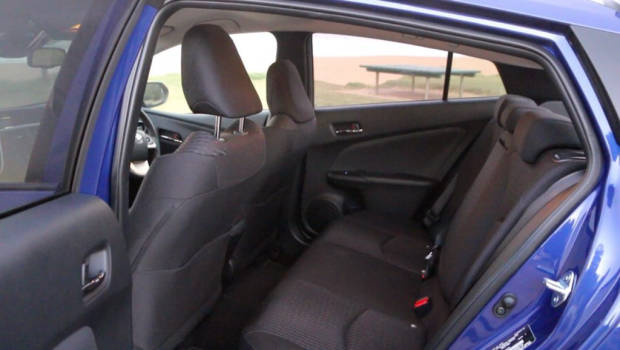
The back seat of the Prius.
The front cabins of both cars are quite practical, featuring a plethora of cubbies to store everyday items. The Prius has a massive central box that can fit a laptop inside, plus two large cupholders ahead of it, a single USB port, a wireless phone charging pad, and reasonable doorbins. The Ioniq has even more spaces, including sectioned doorbins, a larger glovebox, two deep cupholders and a wireless phone charging pad underneath the air conditioning controls, which also houses two USB ports. The Ioniq’s centre box is much smaller than the Prius’, though – no laptop storage here.
Practicality winner: Prius
Hyundai are yet to announce pricing for the Ioniq, but it’s likely that the hybrid will follow the rest of the Hyundai range in offering low scheduled maintenance costs. Like other Hyundai cars, the Ioniq will most likely benefit from capped price servicing for life.
Hyundai covers all its vehicles with a 5 year/unlimited km warranty. Toyota’s warranty is drastically inferior, with coverage limited to 3 years/100,000km, though the Prius battery is warranted for 8 years/160,000km. Hyundai is yet to announce any specific parts warranties for its incoming hybrid and fully electric vehicles.
Toyota have a capped price servicing programme for its vehicles, and Prius servicing is capped for 3 years/60,000km. Annoyingly, the Prius must be serviced every six months or 10,000km – more recent Toyota models have been moved to annual servicing. It is very inexpensive to service the Prius, though: $140 per 10,000km or six months, which means an annual $280 service cost for most Australians, which is entirely reasonable.
A clear thread runs through this comparison that favours one car over the other.
Toyota are now in their third decade building hybrid cars, but longevity counts for almost naught when a rival is allowed to walk in with a superior electric powertrain and more features at what is highly likely to be a more attractive price.
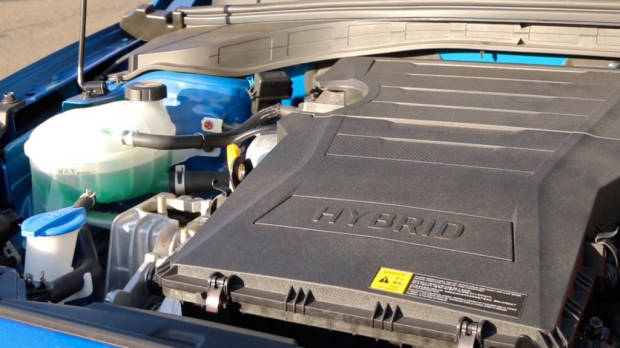
That is precisely what the Hyundai Ioniq Premium hybrid will do if it arrives on the Australian market at around $35,000 before on-road costs, as its maker says it will.
It is true that the Prius is the slightly better car in terms of driving dynamics and passenger space – and it benefits from a quality, interesting cabin – but in the absolutely critical disciplines here of fuel efficiency, engine performance, high-mileage comfort and value for money, the Hyundai steams ahead.
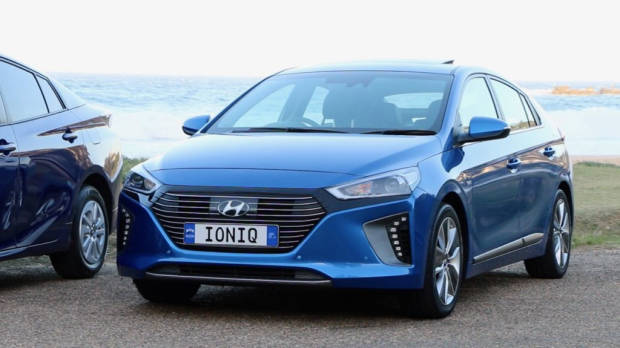
Plus, the Ioniq demonstrates deep thinking on the part of Hyundai in their choice to make the Ioniq deliberately vanilla. Where the Prius has become daring, polarising, to look at, the Hyundai is conservative and safe. Sure, it’s a little boring inside and out, but it will make it even easier for people to adopt more economical driving technology, which has to be the main goal here.
The Prius deserves real credit for focussing more attention in the last couple of years on driving dynamics – the TNGA platform is a real highlight. But the next generation of Toyota’s hybrid will need to step up a lot more again. Toyota need to bring better battery tech to Australia to drive fuel consumption down even further, and if Hyundai is able to deliver a $35,000 price for their top-shelf Ioniq hybrid, look out.
This market is highly price elastic and it looks like, just as Apple walked into mobile phones and stole the game away from the entrenched brands, Hyundai are poised to do the same with the Ioniq lineup.
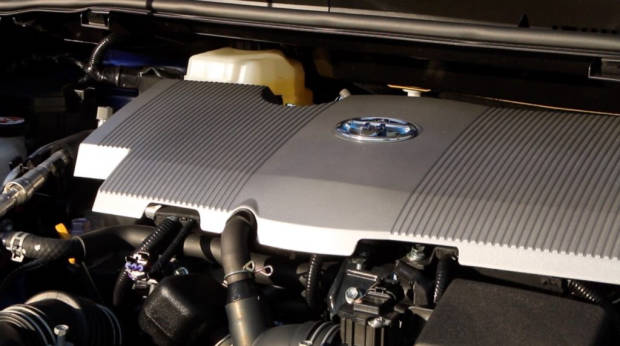
Latest comparisons
About Chasing cars
Chasing Cars reviews are 100% independent.
Because we are powered by Budget Direct Insurance, we don’t receive advertising or sales revenue from car manufacturers.
We’re truly independent – giving you Australia’s best car reviews.